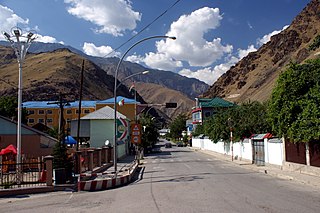
Tajikistan, officially the Republic of Tajikistan, is a landlocked country in Central Asia. It has an area of 142,326 km2 (54,952 sq mi) and an estimated population of 9,750,065 people. Dushanbe is the country's capital and largest city. It is bordered by Afghanistan to the south, Uzbekistan to the west, Kyrgyzstan to the north, China to the east and is separated narrowly from Pakistan by Afghanistan's Wakhan Corridor. Tajiks form the ethnic majority in the country and the historical Tajik homeland lies in present-day Tajikistan as well as parts of Afghanistan and Uzbekistan.

Most of rugged Tajikistan's transportation system was built during the Soviet era, and since that time the system has deteriorated badly because of insufficient investment and maintenance. In 2013, Tajikistan, like many of the other Central Asian countries, was experiencing major development in its transportation sector. Beginning in 2005, a series of major transportation projects begun. The first such project, the Anzob Tunnel, was inaugurated in 2006, providing a year-round road link from Dushanbe to northern Tajikistan.

Dushanbe is the capital and largest city of Tajikistan. As of January 2022, Dushanbe had a population of 1,201,800 and that population was largely Tajik. Until 1929, the city was known in Russian as Dyushambe, and from 1929 to 1961 as Stalinabad, after Joseph Stalin. Dushanbe is located in the Gissar Valley, bounded by the Gissar Range in the north and east and the Babatag, Aktau, Rangontau and Karatau mountains in the south, and has an elevation of 750–930 m. The city is divided into four districts, all named after Persian historical figures: Ismail Samani, Avicenna, Ferdowsi, and Shah Mansur.

Tajik, also called Tajiki Persian or Tajiki, is the variety of Persian spoken in Tajikistan and Uzbekistan by Tajiks. It is closely related to neighbouring Dari of Afghanistan with which it forms a continuum of mutually intelligible varieties of the Persian language. Several scholars consider Tajik as a dialectal variety of Persian rather than a language on its own. The popularity of this conception of Tajik as a variety of Persian was such that, during the period in which Tajik intellectuals were trying to establish Tajik as a language separate from Persian, prominent intellectual Sadriddin Ayni counterargued that Tajik was not a "bastardised dialect" of Persian. The issue of whether Tajik and Persian are to be considered two dialects of a single language or two discrete languages has political sides to it.

The Tajik Soviet Socialist Republic, also commonly known as Soviet Tajikistan, the Tajik SSR, or simply Tajikistan, was one of the constituent republics of the Soviet Union which existed from 1929 to 1991 located in Central Asia.

Kulob, formerly also Kulyab, is a city in Khatlon Region, southern Tajikistan. Located 203 km (126 mi) southeast of the capital Dushanbe on the river Yakhsu, it is one of the largest cities in the country. Its population is estimated at 106,300 for the city proper and 214,700 for the city with the outlying communities (2020). The city is served by Kulob Airport.

Bokhtar, previously known as Qurghonteppa or Kurganteppa, is a city in southwestern Tajikistan, which serves as the capital of the Khatlon region. Bokhtar is the largest city in southern Tajikistan, and is located 100 kilometres (62 mi) south of Dushanbe and 150 kilometres (93 mi) north of Kunduz, Afghanistan.

Vahdat is a city in western Tajikistan, on the bank of the Kofarnihon River, 21 km east of Dushanbe. It was previously called Yangi-Bozor (1927–1936), Orjonikidzeobod and Kofarnihon (1993–2006). Its population is estimated at 43,200 for the city proper and 342,700 for the city with the outlying communities (2020). Vahdat was the focus on international attention in 2019 when a riot occurred in the city's prison, believed to be instigated by members of Islamic State, which led to the deaths of three guards and 29 inmates.

Khatlon Region, one of the four provinces of Tajikistan, is the most populous of the four first level administrative regions. It is situated in the southwest of the country, between the Hisor (Gissar) Range in the north and the river Panj in the south and borders on Afghanistan in the southeast and on Uzbekistan in the west. During Soviet times, Khatlon was divided into Kurgan-Tyube (Qurghonteppa) Oblast – with the Kofarnihon and Vakhsh river valleys – and Kulob Oblast – with the Kyzylsu and Yakhsu river valleys. The two regions were merged in November 1992 into today's Khatlon Region. The capital city is Bokhtar, formerly known as Qurghonteppa and Kurgan-Tyube.

Khujand, sometimes spelled Khodjent and known as Leninabad from 1936 to 1991, is the second-largest city of Tajikistan and the capital of Tajikistan's northernmost Sughd province.

The Tajikistani Civil War, also known as the Tajik Civil War, began in May 1992 and ended in 1997. Regional groups from the Garm and Gorno-Badakhshan regions of Tajikistan rose up against the newly formed government of President Rahmon Nabiyev, which was dominated by people from the Khujand and Kulob regions. The rebel groups were led by a combination of liberal democratic reformers and Islamists, who would later organize under the banner of the United Tajik Opposition. The government was supported by Russian military and border guards.

Districts under Tajikistan Central Government Jurisdiction, also translated as Districts of Republican Subordination or Districts under Republic(an) Subordination, formerly called Karotegin Province, is a region in Tajikistan, consisting of 9 districts and 4 district-level cities that are directly under central administration. Dushanbe, the capital of Tajikistan, is surrounded by the Districts under Central Government Jurisdiction, but not part of it. The region covers an area of 28,500 square kilometres, and has a total population of 2,165,900 (2020), The Districts' ethnic composition in 2010 was 85% Tajik and 11.7% Uzbek.

Qal'ai Khumb or Qal'a-i-Khum, also Kalai-Khumb, is a small town located in the Gorno-Badakhshan Autonomous Region in Tajikistan on the border with Afghanistan. Formerly it was the capital of the independent Principality of Darvaz. Now it is the capital of the Darvoz District of Tajikistan. Here the Pamir Highway meets the Panj River.

The Kofarnihon is one of the major tributaries of the Amu Darya in Tajikistan. The river is 387 kilometres (240 mi) long and has a basin area of 11,600 square kilometres (4,500 sq mi). It rises on the southern slopes of Gissar Range in Vahdat district, formerly Kofarnihon district, and flows in the general south-western direction past the cities of Vahdat and Dushanbe, where it turns south and runs through Khatlon Province toward the border with Afghanistan. It falls into Amudarya some 40 km west of the confluence point of Vakhsh and Panj rivers. The Kofarnihon is an important source of drinking water, and yet it is highly polluted by irrigation runoff and inadequately cleaned recycled water around the cities of Dushanbe and Vahdat.
The population of Afghans in Tajikistan consists largely of Afghan refugees from the various wars which have plagued neighboring Afghanistan. They form the vast majority of all refugees in Tajikistan; the other refugees in the country include a few Uyghurs and Iraqis.

As of March 2017, the total length of Uzbekistan's main railway network is 4,714 kilometres (2,929 mi). A large percentage of the system's track requires major repair. The main line is the portion of the Transcaspian Railroad that connects Tashkent with the Amu Darya. There are rail links with Kazakhstan, Kyrgyzstan, Tajikistan, Afghanistan, and Turkmenistan. Suburban traffic only exists around Tashkent.

Rail transport in Tajikistan is limited, as the railroad system totals only 680 kilometres (420 mi) of non-electrified, single-track railway, all of it 1,520 mm broad gauge. The system connects the main urban centres of western Tajikistan with points in neighboring Uzbekistan. In 1999 a new line connected the southern cities of Bokhtar and Kulob. In 2016, another line connected both cities to the capital Dushanbe, thus linking southern and central railway networks together. The northern branch around Khujand remains physically disconnected from this main Tajik railway network, accessible only through a lengthy transit via Uzbekistan. As of 2017, the passenger service remains limited to infrequent international trains from Dushanbe and Khujand to Moscow, one weekly train from Dushanbe to Khujand as well as a local service between Dushanbe and Pakhtaabad (daily) and Kulyob/Shahrtuz.

Visitors to Tajikistan must obtain a visa from one of the Tajikistan diplomatic missions unless they come from one of the visa exempt countries or countries whose citizens are eligible for an electronic visa.

The COVID-19 pandemic in Tajikistan is part of the worldwide pandemic of coronavirus disease 2019 caused by severe acute respiratory syndrome coronavirus 2. The virus was confirmed to have spread to Tajikistan when its index cases, in Dushanbe and Khujand, were confirmed on 30 April 2020.

A list of roads in Tajikistan.



















